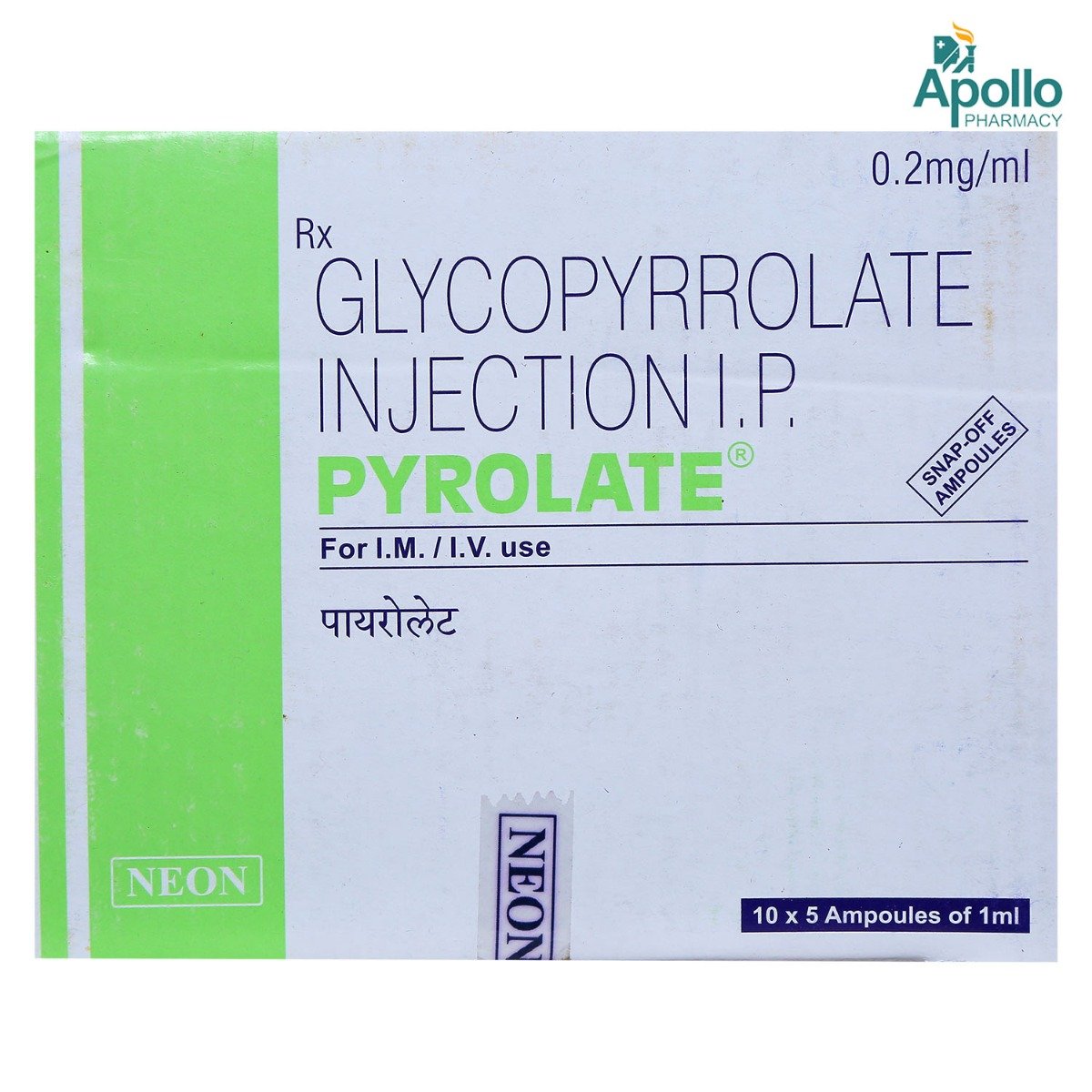- Home
- Pyrofit 0.2 Injection 1 ml
Pyrofit 0.2 Injection 1 ml Substitute
Pyrofit 0.2 Injection 1 ml Substitute
Medicine Composition:
GLYCOPYRROLATE-0.2MGAll Substitutes & Brand Comparisons
RX
Out of StockPyrolin 0.2mg Injection
₹12.85
(₹11.56 per unit)
90% CHEAPERRX
Out of StockGpyrolon 0.2mg Injection
₹13.46
(₹12.11/ 1ml)
90% CHEAPERRX
Out of StockPyrolate Injection 10 ml
Neon Laboratories Ltd
₹142
(₹12.78/ 1ml)
89% CHEAPERRX
Out of StockThemipyrrnom 0.2 Injection 1 ml
Themis Medicare Ltd
₹14.5
(₹13.05/ 1ml)
89% CHEAPERRX
Out of StockGpyrolon 0.2 mg Injection 1 ml
Celon Laboratories Pvt Ltd
₹15
(₹13.5/ 1ml)
89% CHEAPERRX
LICOLATE INJECTION 1ML
₹15
(₹13.5/ 1ml)
89% CHEAPERRX
PYROTROY INJECTION 1ML
Troikaa Pharmaceuticals Ltd
₹16
(₹14.4/ 1ml)
88% CHEAPERRX
Out of StockGlypro 0.2 mg/ml Injection 1 ml
Jackson Laboratories Pvt Ltd
₹16.5
(₹14.85/ 1ml)
88% CHEAPER

When Should You Consider Switching from Pyrofit 0.2 Injection 1 ml?
Patients may explore substitutes in the following scenarios:
- High monthly cost of Pyrofit 0.2 Injection 1 ml
- Non-availability in local pharmacies
- Generic recommendation by a doctor
- Side effects or better tolerability with alternatives
What to Know Before Switching
Before you switch from Pyrofit 0.2 Injection 1 ml to another medicine, here are some important points to keep in mind:
Same salt, different brands:
Most substitutes contain the same active ingredient - GLYCOPYRROLATE-0.2MG, but the fillers, coating, or manufacturing quality may vary slightly.
Consult your doctor first:
Even if the salt is the same, your doctor can confirm if the substitute is right for your condition, dosage, and health history.
Watch out for allergies or reactions:
Some people may react differently to certain brands due to inactive ingredients. If you notice any side effects, inform your doctor immediately.
Price ≠ effectiveness:
A lower-priced substitute doesn't mean it's less effective. Many generic medicines work just as well as branded ones.
Check the dosage form and strength:
Always match the substitute’s strength (e.g., 5mg, 10mg) and form (tablet, capsule, syrup) with what your doctor prescribed.
Uses
Medicinal Benefits
Pyrofit 0.2 Injection 1 ml belongs to the group of medications called 'anticholinergics' indicated in anaesthesia for reduction of airway or gastric secretions, volume and acidity of gastric secretions, and blockade of cardiac inhibitory reflexes during induction of anaesthesia and intubation, intraoperatively to counteract surgically or drug-induced or vagal reflex associated arrhythmias, and for protection against peripheral muscarinic effects of cholinergic agents. It is also used as adjunctive therapy for treating peptic ulcers when an immediate anti-cholinergic effect is desired or oral medication is not feasible. Pyrofit 0.2 Injection 1 ml contains 'Glycopyrrolate', which works by inhibiting the action of acetylcholine. Thus, reduces gastric secretions' volume and free acidity and controls excessive pharyngeal, bronchial, and tracheal secretions.
FAQs
The substitutes of Pyrofit 0.2 Injection 1 ml contain the same active salt(s) - GLYCOPYRROLATE-0.2MG. However, they may differ in price, manufacturing quality, and inactive ingredients. Speak to your doctor to find a suitable option.
Switching to a generic substitute medicine in the place of Pyrofit 0.2 Injection 1 ml is often possible if it has the same salt, strength, and dosage form. But always check with your doctor before making any changes to your medication.
Generics versions of Pyrofit 0.2 Injection 1 ml are typically more affordable because they don’t include the original brand's research, development, and marketing costs. They contain the same active ingredient and are approved for safety and effectiveness.
Most people don’t notice any difference. However, some may react to different fillers or coatings. If you notice any unusual symptoms after switching, consult your doctor.
Make sure the new medicine has the same active salt, strength, dosage form. Always confirm the change with your doctor or pharmacist.
Substitutes of Pyrofit 0.2 Injection 1 ml meet the same safety and efficacy standards as Pyrofit 0.2 Injection 1 ml, but small differences in absorption or formulation can exist. A doctor can help you choose the right one for your needs.
Yes. Substitutes of Pyrofit 0.2 Injection 1 ml may vary in color, size, or shape due to differences in manufacturing and branding, but this does not affect how they work.
Yes, it’s generally safe to switch between multiple substitutes of Pyrofit 0.2 Injection 1 ml if they have the same salt and strength. However, always inform your doctor so they can monitor how your body responds.
Yes, many people safely use substitutes of Pyrofit 0.2 Injection 1 ml for long-term treatment. Just ensure it’s done under medical supervision.
If your symptoms stay under control or lab results remain stable, the substitute for Pyrofit 0.2 Injection 1 ml is likely working well. Regular follow-ups with your doctor are important.
Absolutely. Even with the same salt, small differences can affect how your body responds when switching from Pyrofit 0.2 Injection 1 ml to its substitute. Always consult your doctor before switching.
Buy best C.n.s Drugs products by
Intas Pharmaceuticals Ltd
Sun Pharmaceutical Industries Ltd
Torrent Pharmaceuticals Ltd
Alkem Laboratories Ltd
Abbott India Ltd
Cipla Ltd
Alteus Biogenics Pvt Ltd
Micro Labs Ltd
Lupin Ltd
Ipca Laboratories Ltd
D D Pharmaceuticals Pvt Ltd
Icon Life Sciences
Mankind Pharma Pvt Ltd
Tripada Healthcare Pvt Ltd
Arinna Lifesciences Ltd
Linux Laboratories Pvt Ltd
East West Pharma India Pvt Ltd
La Renon Healthcare Pvt Ltd
Talent India Pvt Ltd
Tas Med India Pvt Ltd
Zydus Healthcare Ltd
Cnx Health Care Pvt Ltd
Eris Life Sciences Ltd
Leeford Healthcare Ltd
Emcure Pharmaceuticals Ltd
Macleods Pharmaceuticals Ltd
Sigmund Promedica
Aristo Pharmaceuticals Pvt Ltd
Dr Reddy's Laboratories Ltd
Troikaa Pharmaceuticals Ltd
Consern Pharma Ltd
Zydus Cadila
Shine Pharmaceuticals Ltd
Wockhardt Ltd
Ardent Life Sciences Pvt Ltd
Crescent Formulations Pvt Ltd
Theo Pharma Pvt Ltd
Reliance Formulation Pvt Ltd
Ikon Pharmaceuticals Pvt Ltd
Propel Healthcare
Neon Laboratories Ltd
Jagsam Pharma
Msn Laboratories Pvt Ltd
Morepen Laboratories Ltd
Pulse Pharmaceuticals
Sanofi India Ltd
Med Manor Organics Pvt Ltd
Hetero Healthcare Pvt Ltd
Novartis India Ltd
Crescent Therapeutics Ltd
Elder Pharmaceuticals Ltd
Solvate Laboratories Pvt Ltd
Akumentis Healthcare Ltd
Mova Pharmaceutical Pvt Ltd
Psyco Remedies Ltd
Tripada Lifecare Pvt Ltd
Ajanta Pharma Ltd
Cyrus Remedies Pvt Ltd
Medishri Healthcare Pvt Ltd
Cadila Healthcare Ltd
Glenmark Pharmaceuticals Ltd
Matteo Health Care Pvt Ltd
Hbc Life Sciences Pvt Ltd
Lyf Healthcare
Matias Healthcare Pvt Ltd
Mesmer Pharmaceuticals
Alembic Pharmaceuticals Ltd
Capital Pharma
Crescent Pharmaceuticals
Medopharm Pvt Ltd
Alniche Life Sciences Pvt Ltd
Kivi Labs Ltd
Talin Remedies Pvt Ltd
USV Pvt Ltd
Quince Lifesciences Pvt Ltd
Solis Pharmaceuticals
Infivis Life Care
Zuventus Healthcare Ltd
Cadila Pharmaceuticals Ltd
Pfizer Ltd
Wallace Pharmaceuticals Pvt Ltd
A N Pharmacia Laboratories Pvt Ltd
Blue Cross Laboratories Pvt Ltd
Jenburkt Pharmaceuticals Ltd
Lia Life Sciences Pvt Ltd
Mano Pharma
Medley Pharmaceuticals Ltd
Primus Remedies Pvt Ltd
FDC Ltd
Maneesh Pharmaceuticals Ltd
Apex Laboratories Pvt Ltd
Gagnant Healthcare Pvt Ltd
Ozone Pharmaceuticals Ltd
RPG Life Sciences Ltd
Strides Shasun Ltd
Unichem International
GlaxoSmithKline Pharmaceuticals Ltd
Kuresys Labs Pvt Ltd
LA Pharma
Trion Pharma India Llp





